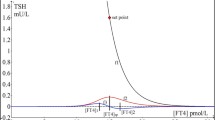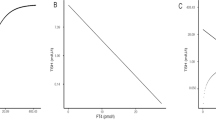Abstract
The components of thyrotropic feedback control are well established in mainstream physiology and endocrinology, but their relation to the whole system’s integrated behavior remains only partly understood. Most modeling research seeks to derive a generalized model for universal application across all individuals. We show how parameterizable models, based on the principles of control theory, tailored to the individual, can fill these gaps. We develop a system network describing the closed-loop behavior of the hypothalamus–pituitary (HP)–thyroid interaction and the set point targeted by the control system at equilibrium. The stability of this system is defined by using loop gain conditions. Defined points of homeostasis of the hypothalamus–pituitary–thyroid (HPT) feedback loop found at the intersections of the HP and thyroid transfer functions at the boundaries of normal reference ranges were evaluated by loop gain calculations. At equilibrium, the feedback control approaches a point defined in both dimensions by a [TSH]–[FT4] coordinate for which the loop gain is greater than unity. This model describes the emergence of homeostasis of the HPT axis from characteristic curves of HP and thyroid, thus supporting the validity of the translation between physiological knowledge and clinical reference ranges.









Similar content being viewed by others
References
Andersen S, Pedersen KM, Bruun NH, Laurberg P (2002) Narrow individual variations in serum T(4) and T(3) in normal subjects: A clue to the understanding of subclinical thyroid disease. J Clin Endocrinol Metab 87:1068–1072
Aström K, Murray RM (2009) Feed back systems (Chapter 3, pp. 73, 102, 275, 322). Princeton University Press, Princeton
Baloch, Z., Carayon, P., Conte-Devolx, B., Demers, L. M., Feldt-Rasmussen, U., Henry, J. F., et al. (2003). Laboratory medicine practice guidelines. Laboratory support for the diagnosis and monitoring of thyroid disease. Thyroid, 13, 3–126.
Degon, M., Chipkin, S. R., Hollot, C. V., Zoeller, R. T., & Chait, Y. (2008). A computational model of the human thyroid. Math Biosci, 212, 22–53.
Dickey, R. A., Wartofsky, L., & Feld, S. (2005). Optimal thyrotropin level: normal ranges and reference intervals are not equivalent. Thyroid, 15, 1035–1039.
Dietrich, J. W. (2002). Der Hypophysen-Schilddrüsen-Regelkreis. Logos-Verlag: Entwicklung und klinische Anwendung eines nichtlinearen modells. Berlin.
Dietrich, J. W., Tesche, A., Pickardt, C. R., & Mitzdorf, U. (2004). Thyrotropic feedback control: Evidence for an additional ultrashort feedback loop from fractal analysis. Cybernet Syst, 35, 315–331.
Dietrich, J. W., & Boehm, B. O. (2006). Equilibrium behaviour of feedback-coupled physiological saturation kinetics. In R. Trappl (Ed.), Cybernetics and systems (pp. 269–274). Vienna: Austrian Society for Cybernetic Studies.
Eisenberg, M., Samuels, M., & DiStefano, J. J, 3rd. (2008). Extensions, validation, and clinical applications of a feedback control system simulator of the hypothalamo-pituitary-thyroid axis. Thyroid, 18, 1071–1085.
Goede SL, Leow MK (2013) General error analysis in the relationship between free thyroxine and thyrotropin and its clinical relevance. Comput Math Methods Med. Article ID 831275.
Goede, S. L., Leow, M. K., Smit, J. W. A., & Dietrich, J. W. (2014). A novel minimal mathematical model of the hypothalamus- pituitary-thyroid axis validated for individualized clinical applications. Math Biosci. doi:10.1016/j.mbs.2014.01.001.
Johansen J (2009) Graph 4.3. A graphical tool. http://www.padowan.dk/graph/
Laurberg, P., Andersen, S., Carle, A., Karmisholt, J., Knudsen, N., & Pedersen, I. B. (2011). The TSH upper reference limit: where are we at? Nat Rev Endocrinol, 7, 232–239.
Leow, M. K. (2007). A mathematical model of pituitary-thyroid interaction to provide an insight into the nature of the thyrotropin-thyroid hormone relationship. J Theor Biol, 248, 275–287.
Li, G., Liu, B., & Liu, Y. (1995). A dynamical model of the pulsatile secretion of the hypothalamo-pituitary-thyroid axis. Biosystems, 35, 83–92.
Norwich, K. H., & Reiter, R. (1965). Homeostatic control of thyroxin concentration expressed by a set of linear differential equations. Bull Math Biophys, 27, 133–144.
Pandiyan, B., Merril, S. J., & Benvenga, S. (2013). A patient-specific model of the negative-feedback control of the hypothalamus-pituitary-thyroid (HPT) axis in autoimmune (Hashimoto’s) thyroiditis. Math Med Biol. doi:10.1093/imammb/dqt005.
Saravanan, P., Siddique, H., Simmons, D. J., Greenwood, R., & Dayan, C. M. (2007). Twenty-four hour hormone profiles of TSH, free T3 and free T4 in hypothyroid patients on combined T3 /T4 therapy. Exp Clin Endocrinol Diabetes, 00, 1–7.
Spencer, C. A., Hollowell, J. G., Kazarosyan, M., & Braverman, L. E. (2007). National Health and Nutrition Examination Survey III Thyroid-stimulating hormone (TSH)-thyroperoxidase antibody relationships demonstrate that TSH upper reference limits may be skewed by occult thyroid dysfunction. J Clin Endocrinol Metab, 92, 4236–4240.
Surks, M. I., Gayotri, G., & Daniels, G. H. (2005). Controversy in clinical endocrinology the thyrotropin reference range should remain unchanged. J Clin Endocrinol Metab, 90(9), 5489–5496.
Vanderpump, M. P., Tunbridge, W. M., French, J. M., Appleton, D., Bates, D., Clark, F., et al. (1995). The incidence of thyroid disorders in the community: A twenty-year follow-up of the Whickham Survey. Clin Endocrinol, 43, 55–68.
Vassart, G., & Costagliola, S. (2011). G protein-coupled receptors: Mutations and endocrine diseases. Nat Rev Endocrinol, 7, 362–372.
Vejbjerg, P., Knudsen, N., Perrild, H., Laurberg, P., Pedersen, I. B., Rasmussen, L. B., et al. (2006). The association between hypoechogenicity or irregular echo pattern at thyroid ultrasonography and thyroid function in the general population. Eur J Endocrinol/Eur Fed Endocrine Soc, 155, 547–552.
Wartofsky, L., Van Nostrand, D., & Burman, K. D. (2006). Overt and ‘subclinical’ hypothyroidism in women. Obstet Gynecol Surv, 61, 535–542.
Author information
Authors and Affiliations
Corresponding author
Rights and permissions
About this article
Cite this article
Goede, S.L., Leow, M.KS., Smit, J.W.A. et al. Hypothalamus–Pituitary–Thyroid Feedback Control: Implications of Mathematical Modeling and Consequences for Thyrotropin (TSH) and Free Thyroxine (FT4) Reference Ranges. Bull Math Biol 76, 1270–1287 (2014). https://doi.org/10.1007/s11538-014-9955-5
Received:
Accepted:
Published:
Issue Date:
DOI: https://doi.org/10.1007/s11538-014-9955-5




